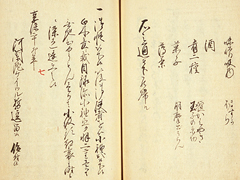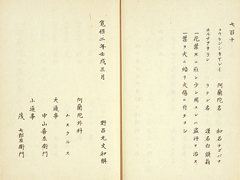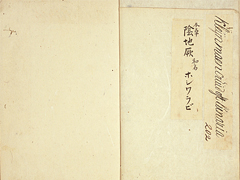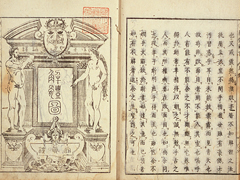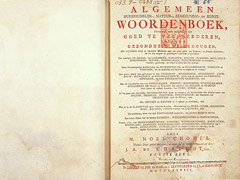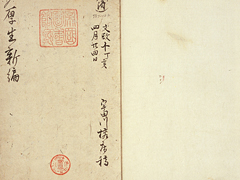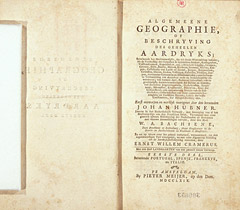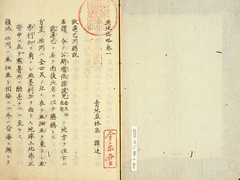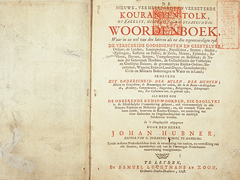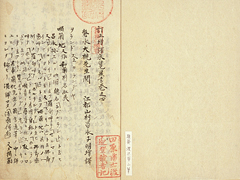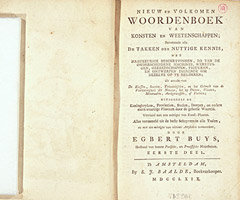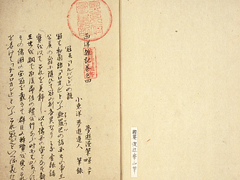Home | Part 1: Tracing the History | 3. Boom in Dutch Studies
Part 1: Tracing the History
3. Boom in Dutch Studies
(1) Tokugawa Yoshimune and the Germination of Dutch Studies
The exchange that was at first limited to trade gradually moved to the exchange of knowledge. The cargo imported by the Dutch ships sometimes included books in Dutch. These books allowed Japanese during the Edo period to learn Western scientific knowledge, which was called Dutch Studies.
Dutch studies started to bud during the reign of the 8th Shogun Tokugawa Yoshimune. He was interested in products from overseas as a means of encouraging new industries and domestic production. To improve horses he imported Western horses via the Dutch ships several times including in 1725, and invited the German-born equestrian H. J. Keijser to teach Japanese people Western horsemanship and horse veterinary medicine. In 1720, he relaxed the Book Ban Order to allow the import of non-Christian-related books, and actively promoted the learning of foreign knowledge, such as having Aoki Kon'yo and Noro Genjo learn the Dutch language.
Long before this, the chief of the Dutch factory had presented the Shogun with R. Dodoens' Cruydt-Boeck in 1659 and J. Jonston's Naeukeurige beschryving van de natuur der viervoetige dieren in 1663, but there was no one who could read them and they lay unread in the Shogunate government library. Yoshimune also showed an interest in these and ordered them translated. There remains today in Oranda honzo wage the results of Noro Genjo's attempt to decipher the books by asking questions of Dutchmen.
These two books were the first Western books to broadly impact scholarship in Japan. In particular, as the representative book on Western botany, Cruydt-Boeck had a major influence on herbal and natural history in Japan. Matsudaira Sadanobu and Hiraga Gennai also worked on the translation of these.
-
Frontispiece of J. Jonston's Naeukeurige beschryving van de natuur der viervoetige dieren
Jonston, J.: Naeukeurige beschryving van de natuur der viervoetige dieren, vissen en bloedloze water-dieren, vogelen, kronkel-dieren, slangen en draken -
Noro Genjo's translation of R. Dodoens' Cruydt-Boeck
Oranda honzo wage. -
Reproduction of an illustration from R. Dodoens' Cruydt-Boeck
Dodoniusu Oranda honzo wage. -
Autograph by Nagasaki interpreter Yoshio Kogyu
Dodoneusu honzo abese ruiju.
(2) Translation of Anatomische Tabellen
The Dutch books provided impetus for acquiring Western learning. This began with efforts to acquire medical knowledge, because it was the most suitable for practical application. Before this, there had been some Nagasaki interpreters who had studied medicine from the Dutch factory doctors and opened practices of their own, but the major innovation came with the publication of Kaitai shinsho, which was the first translation of a systematic Western anatomical book.
This translation effort was led by Maeno Ryotaku who studied first under Aoki Kon'yo and then strove to learn Dutch in Nagasaki from interpreters. He produced many books and translations. His apprentice, Otsuki Gentaku, also studied under Sugita Genpaku and opened the first Dutch school in Edo called Shirando. Gentaku was a central figure in Dutch studies in Edo and served the Shogunate government while also instructing many pupils.
Thereafter, many people learned from Dutch books on pharmacology, natural history, astronomy, chronology, physics, chemistry, geography, and other subjects and went on to publish many books and translations. (II-2) (Column: Hiraga Gennai and Dutch Studies)
(3) Development of Dutch Studies
In this way, many students of Dutch studies implemented and spread foreign knowledge after studying the language under Nagasaki Dutch interpreters or studying Dutch books in Dutch studies schools. Dutch studies would soon spread out to other regions.
It should be noted that in reflection of the way learning was done as the family's business in the Edo period, as with Confucianism and other studies, Dutch studies was also often a family pursuit that was passed down from generation to generation. Representative examples of this are the Sugita family, Katsuragawa family and Udagawa family.
Dutch dictionaries were also compiled. Well known among these are Haruma wage by Inamura Sanpaku, H. Doeff's Zufu haruma and its revised version Oranda jii. All these dictionaries were based on F. Halma's Dutch-French dictionary. Books on grammar were imported and many introductory texts were compiled. (II-3)
During the 19th century, many Russian and British ships sailed close to Japan, and in the northern part of the country there was a clash between Russians and Japanese officials. This incident increased interest in Russia, overseas geography, and military studies, so Dutch studies became an even more practical endeavor. As advocated by Takahashi Kageyasu, in 1811 the Shogunate government established the Bansho Wage Goyo as the official translation organization in which Baba Sajuro, Otsuki Gentaku, Aochi Rinso and others served, and among other works translated N. M. Chomel's Algemeen ... woordenboek as the Kosei shinpen.
Column: Dutch Books Belonged to the Shogunate Government
The National Diet Library houses approximately 3,600 books that previously belonged to the Bureau for the Inspection of Barbarian Books, Kaiseijo, and other Shogunate organizations, and most of these are Dutch books. They are mainly materials transferred from the Tokyo Kaisei School (predecessor of the University of Tokyo) to the Tokyo Shojakukan (Tokyo Library 1875-1877), but the times had already shifted to the studies via English and German, and these Dutch books soon fell into disuse and were forgotten. They were discovered after World War II in the warehouse of the Ueno Library (currently the International Library of Children's Literature), and were recognized as valuable materials on how Dutch learning was acquired during the Edo period and sent shockwaves through the academic community. In addition to the books purchased by the Bureau for the Inspection of Barbarian Books and by Kaiseijo, there were also books that had been handed down by the Tenmonkata (Astronomy Bureau) and Momijiyama Bunko Library. The Dutch books that previously belonged to the Edo Shogunate government went with the Tokugawa Clan when it was relocated to Sunpu (now Shizuoka City), and some of these form the Aoi Collection (Japanese) of the Shizuoka Prefectural Central Library and are also in the possession of such facilities as the Tokyo National Museum.
The arrival of P. F. von Siebold to Japan at that time deserves special mention. As mentioned above, he was sent to Japan with the commission to study Japan and its circumstances, but at the same time he contributed to raising the level of Dutch studies by instructing many Japanese. However, in 1828 when he was returning home, many prohibited items were found among his possessions, which caused the von Siebold Incident. (II-1)
Then in 1839, the Bansha no Goku Affair occurred. The Shogunate government dignitaries who disliked having their foreign policy and other administration intervened by intellectuals and others suppressed these intellectuals such as Watanabe Kazan et al. (II-2)
At this time, however, Western knowledge through Dutch studies and goods from the Netherlands began to make their way to the general public to whom they became familiar. (II-4)
Many Dutch books came to Japan during the Edo period, and there were many Dutch books that received particular attention by Dutch studies scholars in addition to R. Dodoens' Cruydt-Boeck, J. Jonston's Naeukeurige beschryving van de natuur der viervoetige dieren and N. M. Chomel's Algemeene ...woordenboek.
For example, to scholars of Dutch studies, 'zeogarahi' does not refer to the general word 'geography', but to the Algemeene geographie written by the German J. Hubner. This Dutch translation of his Allgemeine Geographie was prized by interpreters and Dutch studies scholars as a source of information on world geography, and many translations and reference works were made from it.
J. Hubner's De nieuwe, vermeerderde en verbeterde kouranten-tolk, of Zakelyk, historisch- en staatkundig woordenboek was much used and called Korantsu toruko or Koranten toruko.
-
De nieuwe, vermeerderde en verbeterde kouranten-tolk, of zakelyk, historisch- en staatkundig woordenboek called Korantsu toruko
Hubner, J.: De nieuwe, vermeerderde en verbeterde kouranten-tolk, of Zakelyk, historish-en staatkundig woordenboek. -
Yamamura Saisuke used Korantsu toruko for his Sairan igen.
Teisei zoyaku Sairan igen.
In addition, Nieuw en volkomen woordenboek van konsten en weetenschappen edited by E. Buys was also used as a reference by many Dutch studies scholars.
-
Nieuw en volkomen woordenboek van konsten en weetenschappen edited by E. Buys
Buys, E.: Nieuw en volkomen woordenboek van konsten en weetenschappen. deel. 1-2. -
Literary works that used Dutch books, such as those by E. Buys and N. M. Chomel
Seiyo zakki. v. 2.
Column: Books Belonged to Watanabe Kazan
In the Meiji era, some archives transferred from the Tokugawa Shogunate to the Tokyo Metropolitan Government.They were originally belonged to the Edo town Magistrates, and finally moved to the Imperial Library. One group from them is called the Watanabe Kazan Library or Kazan Confiscated Books, because these are said to be the books confiscated from Kazan's home when Watanabe Kazan was arrested in the Bansha no Goku Affair. Some of the books have not been confirmed as belonging to Kazan, but about 20 of them bear the Kazan's seal of ownership, or inscriptions, etc., and thus support the story. Almost all the books are important materials that show the interests of Kazan, such as in foreign affairs and world geography. This electronic exhibition introduces several examples in this chapter and Chapter 2 of Part II, but other examples include the Dai Buritania shi and Roshia shi, which are partial translations of J. Hubner's Algemeene geographie, and the Ameirika shi and Korantsu toruko Afurika wage (transcribed by Kazan and included in the Volume 2 of Kaigai jirui zassan) from J. Hubner's kouranten-tolk, and this shows that these Dutch books were often used by Dutch studies scholars.
Kazan's home was within the Tahara Domain's residence in Edo outside Hanzomon (in the vicinity of the present Supreme Court). The National Diet Library is located close to that site, so it might be fate that this collection has come to the National Diet Library.
Copyright © 2009 National Diet Library. Japan. All Rights Reserved

